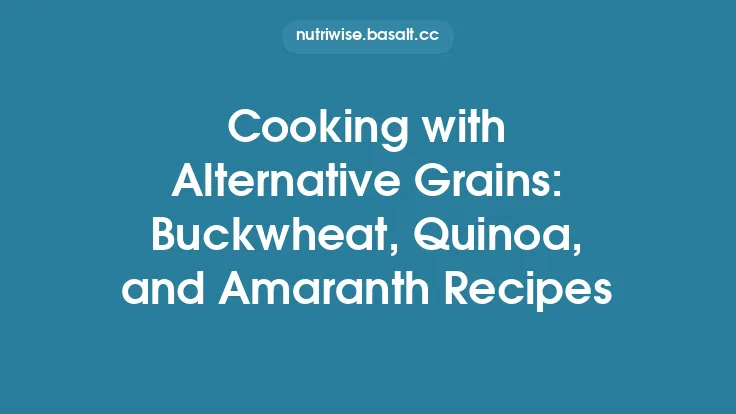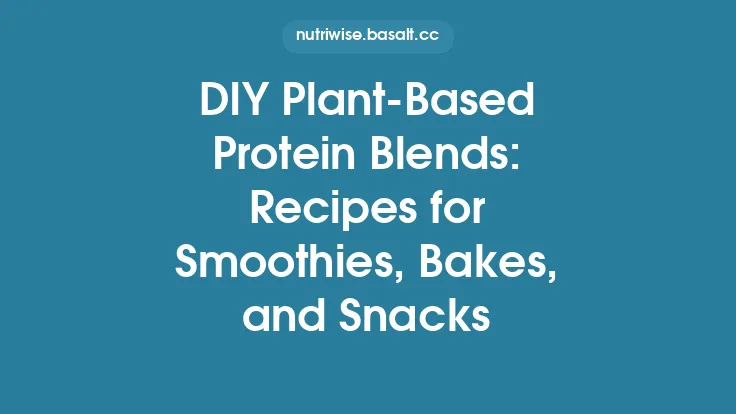When you’re looking to transform a beloved family favorite or a classic comfort dish into a vegan, health‑focused version, the magic often lies in the details of substitution. A well‑chosen swap can preserve—or even enhance—the original’s flavor, texture, and visual appeal while eliminating animal products and reducing saturated fat, cholesterol, and unnecessary additives. Below is a comprehensive guide to the most effective, versatile, and nutritionally sound replacements for common non‑vegan ingredients. By mastering these smart substitutions, you’ll be equipped to re‑imagine everything from soups and sauces to baked goods and casseroles, creating dishes that are both plant‑based and health‑conscious.
Understanding the Role of Each Ingredient
Before diving into specific swaps, it helps to ask three questions about any non‑vegan component you’re considering replacing:
- Function – Is the ingredient providing moisture, fat, binding, leavening, flavor, or structure?
- Flavor Profile – Does it contribute umami, sweetness, acidity, or a particular aromatic note?
- Nutritional Impact – What nutrients (protein, calcium, vitamin B12, etc.) does it supply, and what health concerns does it raise (e.g., saturated fat, cholesterol)?
Answering these prompts lets you match a vegan alternative that fulfills the same culinary role while aligning with health goals.
Dairy Replacements
Milk
| Traditional Milk | Best Vegan Counterpart | Why It Works | Health Note |
|---|---|---|---|
| Whole cow’s milk (3.5% fat) | Unsweetened oat milk (1–2% fat) | Creamy mouthfeel, mild sweetness, good heat stability | Low in saturated fat; adds beta‑glucan fiber |
| 2% reduced‑fat milk | Almond milk (unsweetened) | Light texture, subtle nutty note | Very low in calories; watch for added sugars |
| Full‑fat coconut milk (canned) | Silken tofu blended with water | Thick, rich consistency; neutral flavor | Provides plant protein and calcium; lower saturated fat than coconut |
Technique tip: For sauces that require thickening (e.g., béchamel), simmer oat milk with a roux of flour and a small amount of olive oil. The natural starches in oat milk help achieve a velvety finish without extra thickeners.
Butter
| Traditional Butter | Smart Vegan Swap | How to Use | Health Edge |
|---|---|---|---|
| Salted butter (80% fat) | Melted cold‑pressed avocado oil + nutrient‑dense tahini (1:1 ratio) | Use in sautéing, baking, or as a spread | Avocado oil is high in monounsaturated fats; tahini adds calcium and magnesium |
| Clarified butter (ghee) | Refined coconut oil (for high‑heat) or high‑oleic sunflower oil (for neutral flavor) | Ideal for frying or roasting | Coconut oil offers medium‑chain triglycerides; sunflower oil provides vitamin E |
| Soft butter for pastries | Vegan butter made from a blend of refined oils and emulsifiers (look for non‑hydrogenated, low‑trans options) | Works in flaky pastries when chilled | Choose brands with added phytosterols for cholesterol‑lowering benefits |
Technique tip: When baking, replace each cup of butter with ¾ cup of a solid vegan butter plus ¼ cup of unsweetened applesauce. The applesauce supplies moisture, reduces overall fat, and adds natural sweetness.
Cheese
| Cheese Type | Vegan Alternative | Flavor & Texture Strategy | Nutritional Consideration |
|---|---|---|---|
| Hard Parmesan | Nutritional yeast + ground almonds (2:1) | Toasted briefly to develop a nutty, umami depth | Adds B‑vitamins (including B12 if fortified) and healthy fats |
| Cream cheese | Cashew cream (soaked cashews blended with lemon juice) | Adjust thickness with water; add a pinch of salt | Provides protein, magnesium, and healthy monounsaturated fats |
| Mozzarella (melting) | Aquafaba‑based “vegan mozzarella” (blend aquafaba, tapioca starch, and olive oil) | Heat to activate stretch; season with smoked paprika for depth | Low in saturated fat; aquafaba adds protein and fiber |
Technique tip: For a quick “cheese” topping on pasta, combine nutritional yeast, miso paste, a splash of almond milk, and a dash of garlic powder. Heat gently until smooth, then toss with the hot noodles.
Egg Substitutes
Eggs serve multiple purposes: binding, leavening, emulsifying, and adding richness. Choose a substitute based on the primary function needed.
| Egg Function | Ideal Vegan Substitute | Application |
|---|---|---|
| Binding in burgers, meatballs, or veggie patties | Ground flaxseed (1 tbsp) + water (3 tbsp) – let sit 5 min | Forms a gel that holds ingredients together |
| Leavening in cakes and muffins | Aquafaba (chickpea brine) – 3 tbsp = 1 egg | Whip to stiff peaks for airy structure |
| Moisture & richness in brownies | Mashed ripe banana (¼ cup) or unsweetened applesauce (¼ cup) | Adds natural sweetness; reduce added sugar accordingly |
| Emulsifying in mayonnaise or dressings | Silken tofu (¼ cup) blended with lemon juice and mustard | Creates a creamy, stable emulsion |
| Thickening custards or puddings | Cornstarch slurry (1 tbsp cornstarch + 2 tbsp cold water) + plant milk | Heat gently until thickened; add vanilla for flavor |
Technique tip: For recipes that rely on the yellow color of egg yolks (e.g., hollandaise or custard), incorporate a pinch of turmeric or saffron. This provides visual appeal without altering flavor significantly.
Meat and Seafood Alternatives
When replacing animal proteins, aim for a combination that mimics texture, umami, and mouthfeel while delivering a balanced nutrient profile.
Textured Vegetable Protein (TVP)
- How to use: Rehydrate TVP in hot vegetable broth (1 part TVP to 2 parts liquid) for 10 minutes, then squeeze out excess moisture. Season with smoked paprika, soy sauce, and a splash of balsamic vinegar for depth.
- Health advantage: Low in fat, high in protein, and a good source of iron when fortified.
Mushrooms
- Why they work: Their fibrous structure and natural umami make them excellent stand‑ins for ground meat in sauces, tacos, and shepherd’s pies.
- Best varieties: Portobello (for “steak” slices), shiitake (for a smoky note), and oyster mushrooms (for a delicate texture).
- Preparation tip: Sauté mushrooms with a dash of soy sauce and a pinch of sea salt until they release and reabsorb their moisture, achieving a meaty bite.
Jackfruit
- Ideal for: Pulled “pork” or “chicken” dishes.
- Preparation: Rinse canned young green jackfruit, shred with forks, then simmer in a flavorful broth (e.g., smoked paprika, cumin, tomato paste) for 20 minutes.
- Nutritional note: Low in protein; pair with beans or lentils to boost the amino acid profile.
Seaweed
- Use for: Replicating the briny, oceanic flavor of fish in “fish” tacos or “caviar” garnishes.
- Types: Nori flakes, kelp granules, or dulse sheets.
- Health benefit: Provides iodine, omega‑3 (ALA), and a range of trace minerals.
Technique tip: Combine two or more plant proteins (e.g., TVP + lentils) to achieve a more complete amino acid profile and a richer texture. This also reduces reliance on any single processed ingredient.
Flavor‑Boosting Foundations
Umami Enhancers
- Miso paste (white or red) – add 1–2 teaspoons to soups, sauces, or marinades.
- Sun‑dried tomatoes – finely chopped, they contribute depth to pasta sauces and stews.
- Nutritional yeast – sprinkle into gravies or sprinkle over popcorn for a cheesy note.
- Roasted vegetables – caramelized carrots, onions, or cauliflower can replace the savory backbone traditionally supplied by meat stocks.
Acid & Brightness
- Apple cider vinegar or lemon juice – a splash at the end of cooking lifts flavors without adding sodium.
- Fermented condiments (e.g., kimchi juice, sauerkraut brine) – use sparingly for tang and probiotic benefits, but keep within the scope of “flavor boosters” rather than a full ferment‑focused article.
Sweetness Balance
- Date paste – blend soaked dates with a little water; use 1 tablespoon to replace 1 tablespoon of honey or maple syrup.
- Stevia or monk fruit – for low‑calorie sweetness, especially in baked goods; combine with a bulking agent like oat flour to maintain texture.
Thickening and Binding Agents
| Desired Consistency | Vegan Thickener | How to Apply |
|---|---|---|
| Creamy soups & sauces | Silken tofu blended smooth | Add at the end of cooking; heat gently to avoid curdling |
| Gravy or pan sauce | Arrowroot powder (1 tsp) + cold water (2 tsp) | Stir into hot liquid; thickens instantly without cloudiness |
| Gluten‑free baking | Psyllium husk (1 tsp per cup flour) | Mix with dry ingredients; hydrates during proofing |
| Chewy texture in energy bars | Chia seeds (1 tbsp) + water (3 tbsp) | Let sit 10 min to form a gel before mixing into batter |
Technique tip: When using arrowroot, avoid boiling the mixture after addition, as high heat can break down the starch and thin the sauce again.
Health‑First Considerations
- Saturated Fat Reduction – Swap butter and full‑fat dairy with plant oils rich in monounsaturated fats (olive, avocado) and incorporate nuts/seeds for healthy fat content.
- Sodium Management – Many vegan sauces (soy, miso) are sodium‑dense. Dilute with water or low‑sodium broth, and season with herbs, spices, and acid instead of extra salt.
- Micronutrient Gaps – Ensure adequate calcium (fortified plant milks, tahini, leafy greens), iron (legumes, fortified cereals, cooking with vitamin C‑rich foods), and vitamin B12 (fortified nutritional yeast or supplements). While this article does not delve into protein sources, pairing protein‑rich substitutes (TVP, beans) with the above swaps helps maintain a balanced nutrient profile.
- Fiber Boost – Incorporate whole‑grain flours (spelt, oat) and soluble fiber sources (psyllium, chia) to improve satiety and support digestive health.
Practical Workflow for Converting a Traditional Recipe
- List All Non‑Vegan Ingredients – Identify dairy, eggs, meat, butter, and any hidden animal products (e.g., gelatin, anchovy paste).
- Assign Function to Each – Use the “Understanding the Role” table to decide whether you need moisture, fat, binding, or flavor.
- Select the Corresponding Vegan Swap – Refer to the substitution tables; prioritize whole‑food options before processed alternatives.
- Adjust Ratios – Some swaps (e.g., avocado oil for butter) may require a slight reduction in volume because of higher fat density.
- Taste & Refine – After the first trial, adjust seasoning, acidity, or sweetness. Remember that plant‑based ingredients can mellow during cooking, so a touch more umami or salt may be needed.
- Document Changes – Keep a conversion log for future reference; this builds a personal library of reliable swaps.
Sample Transformations
Classic Beef Stroganoff → Mushroom‑TVP Stroganoff
| Original | Vegan Swap | Reasoning |
|---|---|---|
| Beef strips | Rehydrated TVP + sliced cremini mushrooms | Provides protein, texture, and umami |
| Sour cream | Cashew‑based “sour cream” (soaked cashews + lemon juice) | Creamy, tangy, lower saturated fat |
| Butter | Olive oil + a pinch of smoked paprika | Adds richness without cholesterol |
| Beef broth | Mushroom broth (simmer dried shiitake with aromatics) | Deep flavor base |
| Flour roux | Whole‑grain oat flour + olive oil | Thickens while adding fiber |
Health outcome: Reduced saturated fat by ~70 %, increased fiber, and retained a creamy, satisfying mouthfeel.
Traditional Caesar Salad → Kale‑Based Vegan Caesar
| Original | Vegan Swap | Reasoning |
|---|---|---|
| Anchovy paste | Miso + capers (1 tsp each) | Replicates salty, umami depth |
| Parmesan cheese | Nutritional yeast + ground almonds | Provides cheesy flavor and calcium |
| Egg yolk (emulsion) | Silken tofu + lemon juice | Creates a stable, creamy dressing |
| Romaine lettuce | Massaged kale (olive oil + sea salt) | Adds texture, nutrients, and reduces bitterness |
Health outcome: Boosted vitamin K and calcium, eliminated cholesterol, and added beneficial phytonutrients from kale.
Final Thoughts
Smart substitutions are more than a culinary shortcut; they’re a pathway to healthier, more sustainable eating without sacrificing the pleasure of familiar dishes. By dissecting each ingredient’s purpose, selecting nutritionally superior plant‑based counterparts, and fine‑tuning flavor and texture, you can confidently reimagine any traditional recipe. The result is a vibrant, vegan menu that supports heart health, weight management, and overall well‑being—while still honoring the flavors and comforts you love. Happy cooking!





